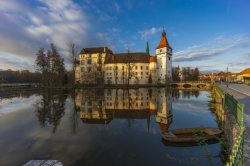Strakonice
At the northwest of southern Bohemia and the confluence of the Otava and Volyňka rivers, we find the district town of Strakonice, which today has more than 24,000 inhabitants. It boasts a rich history, a number of cultural monuments and picturesque surroundings.
Information for visitors
Interesting facts Strakonice
History of the town
There used to be four smaller villages in the area of the current town of Strakonice - Lom, Bezděkov, Žabokrty and Strakonice, which grew over time and eventually merged into one whole. The history of Strakonice is inextricably linked to the existence of the local castle, which was built here by the Bavarians during the first half of the 13th century, from which time we also have the first evidence of the existence of Strakonice.
A very important event dates back to 1243. At that time, the Bavarian family donated part of the castle to the Knights of Malta, thus starting a more than seven hundred year long phase of history. At the beginning of the 15th century, the Johannites became the sole owners of the castle, and subsequently a number of architectural alterations took place on it.
Throughout its existence, Strakonice was a serf town, never a royal town. It is this fact that undoubtedly affected the style of the current development, which does not include the regularity of the streets. The city gained the greatest importance during Bavaria II, who was a great favorite of Přemysl Otakar II. On the contrary, the decline of Strakonice was brought about by the Thirty Years' War and subsequently also by several fires.
In the 18th century, the textile industry made a significant impact in Strakonice, with the creation of a tailor's, draper's guild and hosiery guild. In 1649, the local burgher brewery Nektar was also founded in Srakonice.
Sights and interesting places
The most important landmark of the city is undoubtedly the local castle, a national cultural monument Strakonice. A walk along Palackého náměstí, which is dominated by the Marian column from the second half of the 18th century, is also pleasant. In Strakonice there is also a place of pilgrimage, which is the Church of the Virgin Mary, and it is undoubtedly worth mentioning the Renaissance Church of St. Marquette.
Author: Andrea Štyndlová



